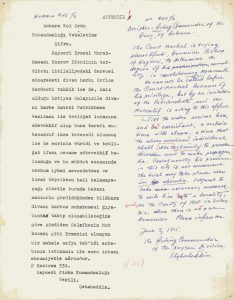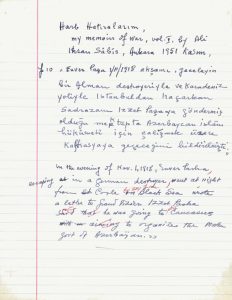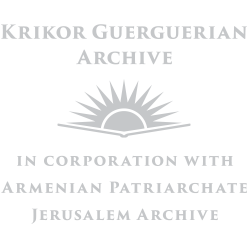We collected the files containing the private works of Krikor Guerguerian and put them in what we now call Archive II. These files are comprised of two major groups of materials. The first group consists of the original Armenian and Ottoman materials that can be found in Archives I and III, along with their translations, which were completed either by Guerguerian himself or by others he hired to translate them. The second group of materials contains Guerguerian’s personal notes. These notes, which were taken in a disorderly fashion, primarily for the purposes of writing books or articles, can be found throughout other various files within the Archive.

Neither the original documents and their translations nor Guerguerian’s personal notes have been categorized or sorted in a systematic fashion. Thus, the files remain disorganized.
Guerguerian, who could speak Turkish, Armenian, English and French, translated the Ottoman (written in the Arabic alphabet) materials into these languages. Naturally, these translations are particularly useful for those who cannot read Ottoman. We would like to add, however, that in some instances the translations contain critical errors that lead to alterations in meaning. We would therefore like to advise all readers to apply caution when utilizing the Turkish, Armenian, English and French materials that were translated by Guerguerian from Ottoman. However, because the Turkish and English translations of all Ottoman documents are available in Archive I, verifying their accuracy can be easily achieved.
The Turkish and English documents contained in Archive II pertain predominantly to the subject of the 1919-1921 Istanbul Committee of Union and Progress Trials. Guerguerian translated nearly every one of these documents. Crucial telegraphs and testimonies by defendants and witnesses revealed during the trials comprise a significant portion of the translations, which we have asked our readers to sift through cautiously. For example, documents acquired during the investigation into the genocide in Yozgat are now at our disposal. As such, the documents taken from the trials provide us with rather detailed information on how the Genocide was organized.
Among the documents Guerguerian translated, we can also encounter the reports of the Investigation Committee (Heyet-i Tahkikiye) dispatched by the Ottoman government to various regions in September 1915 in order to investigate corruption with regards to the Abandoned Properties. These reports, which were sent from Adana, Marash, Diyarbekir, Malatya, Damascus and Aleppo, shed light on aspects of the genocide that were previously unknown.

Guerguerian had prepared multiple books and articles based on these Ottoman documents. The book, Yozğadi Hayasbanutyan Vaverakragan Badmutyunı, written based on documents from the Yozgat Military Tribunals and published in Armenian in 1983, is just one example of such works. The manuscripts of this book’s English translation can be found in this Archive, as well. These translations are strewn across various files rather than collected together. Other important materials contained within this Archive include the manuscripts of books based on documents, such as those from the trials of officers charged with abuse of power in Erzincan in 1917, and those from the Military Tribunals on the Kayseri Trials.
Guerguerian also compiled lists of people guilty of perpetrating genocide in multiple regions, which can also be found among the Turkish and English materials in Archive II. Amongst them, the report that Guerguerian prepared on the participants of the deportations and massacres, orchestrated by Captain Fazil Bey, in Mamuret-ul-Aziz and its surrounding districts are particularly consequential. The fact that this report was written by an Ottoman officer, who witnessed these events first-hand, magnifies its invaluable significance. Furthermore, Guerguerian also prepared comprehensive lists of the perpetrators of the deportations and massacres in cities and regions such as Trabzon, Tekirdag, Bursa, Cilicia, Ankara and Aydin, detailing these person’s names and the crimes they committed.
As previously stated, the files in which this information resides are tremendously disorganized and do not have any systematic configuration whatsoever. It is nearly impossible to systematize and catalog them. It is for this reason that an extensively detailed index was prepared, thereby facilitating the researcher’s ability to access all information contained within the Archive.
